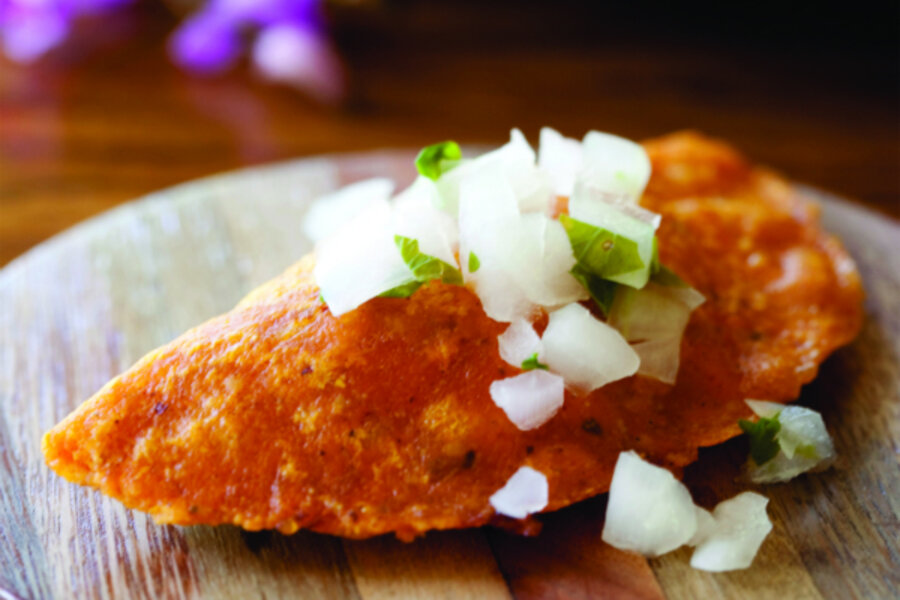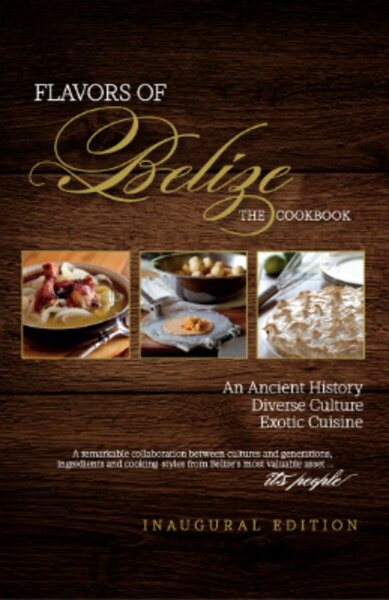A Mayan dinner party for 12.21.12
Loading...
There is a lot of talk about the Mayan calendar rolling over to Dec. 21, 2012 and simply coming to end, which has been translated by some as, that's it, folks. No more time, no more us. I can't say that I agree, since I've already received my 2013 work calendar and everything there seems to be in order just fine. For a more reasoned, scientific explanation, you might want to check out NPR's report, "A Guarantee: The world will not end on Friday."
My first brush with Mayan culture was when I hopped off a cruise ship in Cozumel in 2006 and explored the Chacchoben Mayan ruins. That's where I found a rather modest exhibit sign next to one of the many-stepped pyramid temples indicating that the Mayan calendar would finish up in six years. It tried to be reassuring that while some people interpreted this to mean the end of time, it could also be seen as a restart. A clean slate for all of us.
I'd like to suggest that you give both theories a rest and instead actually learn something about Mayan culture. A good place to start would be with Flavors of Belize: The cookbook created by Tanya McNab and Shelley Bowen Stonesifer. First of all, the Mayans haven't vanished. There are by some estimates some 7 million Mayans alive and well living throughout Guatemala, southern Mexico and the Yucatán Peninsula, Belize, El Salvador, and western Honduras.
In "Flavors of Belize," Mayan culinary traditions are explored alongside those of the British, Mestizo, Creole, Chinese, Lebanese, Garifuna, and more. Belize is a melting pot of all these cultures and this cookbook is an attempt to showcase the best of them, relying on renowned chefs and cooks to share their recipes.
My own second brush with Mayan culture came when I spent a week in Belize learning about the chocolatemaking process – from cacao bean to chocolate bar. After spending one morning tromping around 30-acre cacao farm in the rainforest, we headed to the farmer's homestead for lunch. Afterward we huddled under a pavilion with a rustic, knee-high stove. Some of us perched on plastic lawn chairs, others leaned against the smooth posts that rimmed the edge, and watched as the farmer's adult daughter made us a traditional Mayan chocolate drink.
First, she scooped dried cacao beans onto large sheets of metal balanced over the open flame. She used a dried corn cob to stir the beans to ensure each one felt the heat from the metal to draw out the base, earthy flavors of chocolate.
When the beans were fully roasted she dumped them out on a squat table and used a small round stone to crack the shells off the beans leaving behind cacao nibs. We all took a turn pounding the pile of beans.
Next came the winnowing process, sifting the exposed beans through a mesh pan to allow the lighter outer shells to blow away, leaving behind the meaty nibs. The nibs were then passed through a hand-cranked grinder. This is hard work. The warm jungle air felt even hotter with the heat from the nearby fire and beads of sweat flew as we ground the cacao into chocolate paste.
The smooth paste was shaped into round patties. These were stirred with water, raw sugar, and pepper in large colorful plastic jugs to make the famous Maya chocolate drink.
“Chocolate” is derived from the Mayan word “xocoatl.” Many of us know chocolate as solid bars, but for most of its history – back to 500 B.C. – chocolate has been consumed as a drink. It was revered by Mayan priests and used in ceremonies by royalty. The valuable cacao seeds were traded as a form of currency to barter for corn and other commodities. Spaniard Hernando Cortés discovered storerooms of cacao when he arrived in 1512 to conquer the Aztec.
Expanding trade routes brought cacao to Europe where the Europeans added sugar, a sweetner unknown in Central America. By the 1700s, elite Europeans enjoyed sweetened chocolate drinks, sipping from elaborate cups and discussing politics in “chocolate houses.” The demand for both chocolate and sugar took off, eventually forming the powerful, global industry that it is today.
But Mayans have much more to offer than just chocolate. "Interestingly, many of the recipes we feature in 'Flavors of Belize' can be traced to Maya origins," note the cookbook authors.
Among these are kack'ick soup, panades with hot pepper onion sauce, and a Maya chocolate cake. While Mayans most likely did not eat chocolate cake, it would be easy to agree that all chocolate recipes could be traced to their Maya origins, and as the authors say, chocolate could be considered "among the greatest gifts the ancient world provided to modern-day civilization."
The authors have shared their recipes here, so you can host your own Mayan-themed dinner party on Dec. 21, 2012, ease those ancient-modern worries away with a piece of chocolate cake, and welcome the return of longer days.
Kack’ick Soup
Mariposa Restaurant, Chaa Creek, Cayo
The name, translated from the queck’chi Mayan language, means "Spicy Red Soup."
4 pounds chicken, cut into serving sizes
2 inch piece of ginger root, peeled, diced
6 to 8 cloves garlic
1/2 cup cilantro, diced
6 medium tomatoes, deseeded
4 medium green bell peppers, deseeded
1 teaspoon dried chilies, to taste
1 tablespoon red recado*
1 cube chicken bouillon, optional
Spicy red chili powder, to taste
Salt and freshly ground black pepper, to taste
2 tablespoons cilantro, minced, for garnish
1 ripe avocado, diced, for garnish
Place chicken, salt, ginger root, 3 cloves garlic and 1/4 cup cilantro in a large pot with enough water to cover the chicken.
Bring to a boil then reduce heat to simmer until chicken is cooked. Grill the remaining garlic, tomatoes and green peppers. Soak the dried chilies in broth until tender.
Purée all grilled vegetables, red recado, the remaining cilantro and the soaked chilies. Sieve the purée, pour into the broth, add chicken bouillon, spicy red chili powder, black pepper and simmer forapproximately 15 to 20 minutes.
Serve with coconut white rice and garnish with cilantro and avocado.
*Red recado paste
Red recado is a Maya spice paste particularly popular in the Yucatan region of Mexico. A deep brick red, racado rojo is the most common, and is an essential ingredient of the region's famous slow-roasted pork dish, cochinita pibil. Use it as a flavoring rub for pork, chicken, and fish. Recado rojo can be bought at Latin markets in brick-shaped packages.
5 tablespoons annatto seeds
6 to 7 allspice seeds
1/4 teaspoon whole cloves
1/4 cup sour orange
1/4 cup vinegar
Grind annatto seeds, allspice seeds and whole cloves to a powder. Combine annatto powder with sour orange and 1/4 cup of vinegar and process to a paste. May add more sour orange and vinegar if necessary to achieve a thick paste. Store in refrigerator.
Panades
Serves 4 to 6
You may also fill with refried beans. When using refried beans, eliminate red recado paste from the recipe. Locally, cooks use red recado to differentiate between panades fillings. The red color from the recado paste, represents the fish, and the plain masa is for the beans.
1-1/2 pounds corn masa or 2 cups Quaker® Masa Harina de Maiz mix
1 teaspoon baking powder
1 teaspoon salt
1/2 teaspoon red recado paste (see below)
1/4 cup water
1-1/2 cups fish filet, cooked, flaked
Vegetable oil for frying
Tortilla press
Fish filling:
2 pounds fish filet
6 epazote leaves, minced
2 to 3 tablespoons cilantro leaves, minced
1-1/2 teaspoons salt
1 teaspoon freshly ground black pepper
2 tablespoons onion, minced
1 teaspoon garlic, minced
Place fish, epazote and cilantro in a pot with enough water to cover, boil until fish is cooked. Approximately 15 minutes Remove fish from pot and cool. Flake fish, combine with salt, black pepper, onion and garlic.
Mix masa, baking powder and salt. Dissolve recado in water and add to masa until soft and masa holds. If using Masa harina, follow instructions on package. Form into 1-1/2 inch balls. Place ball of masa in between 2 sheets of parchment paper in the center of a tortilla press and flatten. Place approximately 1 teaspoon of fish in the middle and fold over to form a patty, press edges to seal. Do not overfill.
Heat oil in a large frying pan and fry panades until it floats, turn and cook until slightly crisp. Serve with hot pepper onion sauce (recipe below).
Hot pepper onion sauce
2 cups onions, minced
2 habanero peppers, deseeded, sliced
2 tablespoons cilantro, minced
6 allspice seeds
1-1/2 cups vinegar
1/2 cup water
1 teaspoon salt
Combine all ingredients and marinate for 2 hours or overnight. Will keep for several weeks in refrigerator.
Maya Chocolate Cake
Chan Chich Lodge, Gallon Jug, Orange Walk
1-1/2 cups buttermilk
1-1/2 cups canola oil
1-1/2 teaspoons vanilla
2-1/2 cups sugar
3 eggs
2-1/2 cups all-purpose flour
1 tablespoon baking soda
1 cup cocoa powder
1/2 teaspoon salt
1-1/2 cups boiling water
Preheat oven to 350 degrees F. Grease two 9-inch round cake pans. Dust with flour and line withparchment paper. Combine buttermilk, oil, vanilla and sugar in a bowl. Add eggs oneat a time, blending thoroughly. In a separate bowl, sift the dry ingredients.
Combine dry ingredients with wet ingredients 1/2 cup at a time, mixing with water as needed. Mix until well blended. Pour batter evenly into the two baking pans. Bake 40 minutes or until knife inserted in middle comes out clean. Cool in pans for 10 minutes, loosen sides, thencool to room temperature and remove from pan.
Chocolate icing
1/2 cup butter, room temperature
1-1/2 teaspoons vanilla
4 cups powdered sugar
1/4 teaspoon salt
3/4 cup cocoa powder
1/2 cup boiling water, as needed
Beat butter and vanilla. Sift powdered sugar, salt, and cocoa powder. Add to butter, alternating with boiling water as needed. Beat at highest speed until creamy. If frosting is too thick, add water 1 teaspoon at a time. If the frosting is too soft, add powdered sugar, 1 teaspoon at a time.









